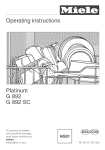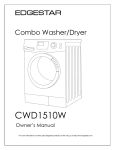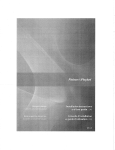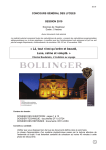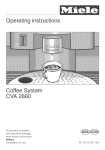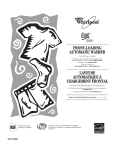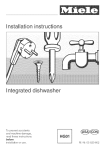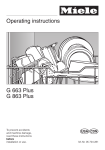Download Miele G 1171 Operating instructions
Transcript
Operating instructions Novotronic G 842 Plus G 842 SC Plus To prevent accidents and machine damage, read these instructions before installation or use, M-Nr, 06 088 620 Contents Contents Changing a program ............................................... Program guide .................................................... 32 33 FrequentJy asked questions ........................................ After sales service ................................................ 34 39 Transport 40 ....................................................... User Maintenance Cleaning Cleaning Cleaning Cleaning the the the the instructions ...................................... filter in the wash cabinet .................................. spray arms ............................................ wash cabinet .......................................... door and door seal ...................................... Cleaning the exterior ............................................... Cleaning the water inlet filter ......................................... Cleaning the drain pump and non-return valve ........................... 41 42 44 45 45 45 46 47 iMPORTANT SAFETY iNSTRUCTiONS WARNING When using your dishwasher, follow basic precautions, including the following: Read aH instructions before installation or use of the dishwasher to prevent injury and machine damage. sponsible for damage or injury caused by improper use of this api The manufacturer cannot be held repliance. tended purpose. This appliance is intended for residential i Use the dishwasher onlyuse for only. its in- Do not use an extension cord to i connect this appliance to electricity. Extension cords do not guarantee the required safety of the appliance (e.g. danger of overheating). :} Be certain your appliance is properly installed and grounded by a qualified technician. To guarantee the electrical safety of this appliance, continuity must exist between the appliance and an effective grounding system. It is imperative that this basic safety requirement be met. If there is any doubt, have the electrical system of the house checked by a qualified electrician. The manufacturer cannot be held responsible for damages caused by the lack, or inadequacy of, an effective grounding system. hstaHation Installation and repair work should bebyaMiele authorized service technician. Work by unqualified persons could be dangerous and could void the warranty. Electrical i: safety Before installation make sure that - Fire hazard ooWARNING notcover or crush thep,ugof electric appliance. Ensure that the the vo,tage and frequency ,,sted on an cabinet opening for the dishwasher the data plate correspond with the household electrical supply. This data must correspond to prevent iniury and machine damage. Consult a qualified electrician if in doubt. ,_,,,,,,,_,_,,_ Before instal,ation orservice, disconnect the power supply to the work area by unplugging the unit, "tripping" the circuit breaker or removing the fuse. provides ample space for the plug. Insta!ling the dishwasher in a tight space may crimp the power cord or put pressure on the plug which may cause overheating. iMPORTANT SAFETY iNSTRUCTiONS Use Th,s equ,pment ,snot maritime use or for usedos,gned in mobile for installations such as caravans or aircraft. However, under certain conditions it may be possible for an installation in these applications. Please contact the nearest Miele dealer or the Miele Technical Service Department with specific requirements. i Only use the dishwasher if all pan- e,s are proper,y inplace. _,,,,,_,,,,,_,iii_ Donottamper w,th thecontrols. iHli_i!iJt To reduce therisk ofiin,njury, allow children to play on,do or not near the dishwasher. Inspect the dishwasher for ship- ping damage. Donotinstal, oroperate a damaged unit. Contact the Do not abuse, sit, or stand on the place of purchase. Under certain cond,t,ons, gas may be produced in ahydroge hot wa- i door orbaskets ofthedishwashe Ensure that any plastic wrappings, system that has not been used for bags etc. are disposed ofsafely ter two weeks or more. HYDROGEN GAS and kept out of the reach of babies and young children. Danger of suffocation! This dishwasher should only be installed under a continuous countertop secured to adiacent cabinetry. IS EXPLOSIVE. If the hot water system has not been used for such a period, turn on all hot water faucets and let water flow from each for several minutes before using the dishwasher. This will release any accumulated hydrogen gas. Do not smoke or use an open flame during this time. Do not this dishwasher neath a,nsta,, cooking surface, oven beor any appliance that radiates heat. High temperatures from these units may damage the dishwasher. Donotwash plastic items unless they are labeled "dishwasher safe" or the equivalent. For items not labeled, check the manufacturer's recommendations. Donot, under any circumstances cut the intake hose or submerge in liquid. This hose contains electrical components that could cause iniury or property damage if cut or submerged. iMPORTANT i SAFETY iNSTRUCTiONS When loading tableware, place sharp ,terns away from thedoor seal to prevent damage to the seal. Load knives pointing downwards to prevent injuries. Only use detergents and rinsedishaids recommended for residential washers. Keep all detergents and rinse aids out of the reach of children. DisposaJ of an appJiance , ,fthe app,,anee isremoved from ,ts installation and will not be used, the door to the wash cabinet should be removed to prevent children from being locked in the machine. When discarding an old dishwasher, unplug it from the power outlet, remove the door to the wash cabinet and cut off the power cord. iiliii_iiiiiiiiJf Donot drink water from the d,shwasher! Harmful residues could be present. For dishwashers eJement with visible heating SAVE THESE iiliii_iiiiii!i Do not touch theheating e,ement during or immediately after use. CONSIGNES AVERTISSEMENTAu moment d'utiliser votre Jave-vaisseJJe, prenez des precautions essentieJles, dont : Lisez attentivement J'ensemble des consignes avant d'instaHer ou d'utHiser Je lave-vaisseHe afin de prevenir Jes blessures et eviter d'endommager J'appareH. blessures caus6s par I'usage inappropri6 de I'appareil. Tout usage inapproprie est d6conseill6. Cet appareil est i destin6 responsable de dommages ou a un usage domestique uniquemenL DE S¢:CUF:iIT¢: S6curit6emectrique Avant I'insta!lation, assurez-vous que _taens_oo et_a fr6quence _oU_- qu6es sur la plaque signaletique correspondent bien a celles de I'alimentation 61ectrique de la r6sidence afin de prevenir les blessures et 6viter d'endommager I'appareil. Darts le doute, consultez un 61ectricien qualifie. Avant I'insta!lation ou I'utilisation, coupez I'alimentation 61ectrique, soit en debranchant I'appareil, soit en faisant basculer le disioncteur ou en enlevant le fusible. N'utilisez pas de rallonge pour braooher ,'appare_ a_a source d'alimentation 61ectrique. Les ra!longes ne garantissent pas la securit6 requise pour I'appareil - si vous utilisez une ra!Ionge, cela peut causer la surchauffe. Assurez-vous que votre appareil est insta!16 correctement at mis a la terre par un technicien qualifie. Pour Conservez ces consignes dans un garantir la s6curit6 61ectrique de lieu s0r et transmettez-les a tout I'appareil, il faut le raccorder a un disutilisateur futur. ............................................................................................................................................................. positif de mise a la terre appropri6_ II est essentiel de respecter cette exigence de base en matiere de securit6. Darts le doute, faites verifier I'installation 61ectrique de la r6sidence par un electricien qualifi6. Le fabricant ne peut 6tre tenu responsable de dommages caus6s par I'absence d'un dispositif de mise a la terre ou par un dispositif inadapt6. CONSIGNES OE SECURITE Installation V@ifiez si votre lave-vaisselle n'a pas subi de dommage Iors du L'installation et les reparations devraient 6tre effectu6es uniquement par un technicien de service autoris6 Miele, Les travaux effectu6s par des personnes non qualifi6es peuvent s'av@er dangereux et rendre nulle la garantie, transporL N'installez pas et n'utilisez pas un appareil endommag6. Oommuniquez avec le point de vente cO vous I'avez achet& ATTENTION-Risque d'incendie Ne recouvrez et n'6crasez iamais la fiche d'un appareil 61ectrique, Assu- hors la port6e de b6b6s et d'enfants, Risque de suffocation! rez-vous que dans occup6 de par le lave-vaisselle il y I'espaoe a suffisamment volume libre pour la fiche, Si vous installez le lave-vaisselle dons un espace trop petit, le cordon d'alimentation pourrrait 6tre comprim6 ou une pression pourrait 6tre exerc6e sur la fiche, ce qui risque de causer la surchauffe, Cet appareil n'est pas congu pour usage sur un bateau ou dons des engins mobiles, tels les avions ou les v6hicules r6cr6atifs, Toutefois, son installation est possible dons certaines circonstances, Veuillez communiquer vos exlgences particulieres au d6taillant Miele le plus pres de chez vous ou au service du soutien technique, Assurez-vous que ,es emba,,age les sacs, mati@es plastiques et autres sont correctement elimin6s et tenus Le lave-vaisselle @treinstall6 uniquement sous dolt un cornptoir continu fix6 & des armoires adjacentes, N'instatlez pas ce modele de lave-vaisselle sous une plaque de cuisson, un four ou tout autre appareil qul diffuse de la chaleun Les hautes temp@atures que diffusent ces appareils pourraient endommager le lave-vaisselle, En vous ne de,,ez per aucuncas, le tuyau d'arriv6e d'eau oucouI'immerger, car il contient des composants 61ectriques qui pourraient causer des blessures ou endommager la residence, CONSIGNES Utitieation OE SECURITE Au moment de charger la vaisse!le, ned_sposez pas_es articles cou- pants b, proximit6 H'utU_sez _e _a,,e-vaisse,e Iorsque tousles panneaux que sont bien en place. Ne jouez pas avec les commandes_ Afin de dirninuer le risque de blessures, ne laissez pas les enfants jouer pres de I'appareil ni monter dedans ou dessus. Evitez de malmener la porte ou les pan_ers du_ave-va_sse,e oude vous y appuyer ou asseoin du ioint d'6tanch6it6 de la porte afin d'eviter de I'endommager. Placez lee couteaux avec la pointe vers le bas afin d'eviter les blessures. Utilisez seulement les d6tergents et_es products der_n_age recommand6s pour les lave-vaisselle b, usage domestique. Conservez tous ces produits hors de la port6e d'enfants. Ne consomme zpas_'eau du lave-vaisselle! Elle peut contenir des r6sidus dangereux. Dons certaines circonstances, tout systeme d'eau chaude qui n'a pas servi durant deux semaines ou davantage peut produire de I'hydrogene. L'HYDROGENE EST UN GAZ INFLAMMABLE. Si le systeme d'eau chaude n'a pas servi durant une te!le p@iode, ouvrez tousles robinets d'eau chaude et laissez I'eau couler plusieurs minutes avant d'utiliser le lave-vaisselle. Cette action lib@era I'hydrogene qui aura pu s'y accumuler. Entre-temps, abstenez-vous de ruiner et n'utilisez pas de fiamme nue. Ne lavez pas des articles en plastique non etiquet6s "resiste au lave-vaisse!le" ou une formulation 6quivalente. Consultez les recommandations du fabficant pour les articles non etiquet6s. Lave-vaisseJle munis d'un @t_ment chauffant visibJe Ne touchez pas I'el6ment chauffant pendant ou_mm6d_atement apres I'utilisation. Mise au rebut de J'appareil Si vous d6sinstallez I'appareil et .... comptez ne plus vous en servir, d6tachez-en la porte pour 6viter que des enfants se retrouvent enferm6s dane le tamboun Lorsque vous mettez un lave-vaisselle au rebut, d6branchez-le de la source d'alimentation electrique, d6tachez-en la porte et coupez le cordon d'alimentation. CES CONSlGNES Caring Energy for the environment saving washing This dishwasher is exceptionally economical in the use of water and electricity, For best results follow these tips: [] For lowest energy consumption and the gentlest washing of china and crystal, connect the dishwasher to a cold water source, [] For fastest possible wash times, yet higher energy consumption, connect the dishwasher to a hot water source, [] Make full use of the baskets without overloading for the most economical washing, [] Choose a program that best suits the degree of soiling and the type of dishes being washed, [] If baskets are only half full, select the "Economy" program, [] Use the correct amounts of detergent and rinse aid, 10 Guide to the dishwasher Wash cabinet I 3 4 5 7 8 9 I0 tl 12 1 Upper spray arm (not visible) 7 Four height adiustable feet 2 Cutlery tray 8 Triple Filter System 3 Upper basket 9 Salt reservoir 4 Water feed for middle spray arm 10 Detergent dispenser 5 Middle spray arm 11 Rinse aid reservoir 6 Lower spray arm 12 Data plate 11 Guide to the dishwasher Contro_ panel 13 t9 18 14 15 17 13 "On/Off" button 17 Check/Refill indicators 14 Program sequence display 18 Child Safety Lock 15 "Start" button 19 Door release 16 Program selector 12 16 Before using Ch(ld Safety for the first time Lock [ [ The yellow key for the Child Safety Lock is shipped on one of the spikes at the front of the upper basket. Remove the key before using the dishwasher, !_ The Child Safety Lock is designed to prevent children from opening the dishwasher, [] Press the elease saTcn nslae me cJoor grip tne aoor s ooenea aur(ng oDerauor the dishwasher will stop running, Once the door is closed the program will restart, To c(ose the door [] Push the baskets in, [] Lift the door and push until it clicks into position, [] Use the provided key to lock or unlock the dishwasher, _ Horizontal: the door is locked 1_ Vertical: the door can be opened 13 Before Water using for the first time softener To achieve good cleaning results, the dishwasher needs soft water. Hard water results in calcium deposits on dishware and in the dishwasher. If your tap water hardness is above 8 gr/gal (values are in US gallons) (!40 ppm), the water should be softened. This takes place automatically in the unit's integrated water softener. - - - 14 Your local water authority wil! be able to advise you of the water hardness level in your area. The dishwasher must be programmed to correspond to the water hardness in your area. The water softener must be filled with dishwasher salt for reactivation. If your water hardness is consistently lower than 8 gr/gal (!40 ppm), you do not need to add dishwasher salt. However, the dishwasher must still be programmed to correspond to the local water hardness. Where the water hardness fluctuates e.g. between 9- 17 gr/gal (!60- 3!0 ppm), always program the machine to the higher value, 17 gr/ga! (310 ppm)in this example. If there is a fault, it will help the service technician to know the hardness of your local water supply. [] Please note the water hardness: gr/gal Before using Programming for the first time the water softener Your water hardness level must be programmed into the dishwasher using the program selector and buttons on the control panel, [] Make sure the dishwasher is turned off, Pots & Pans Stop Normal Plus Sani Wash Normal Economy Rinse & Hold [] Turn the program selector to "Stop", [] Press and hold the "Start" button and at the same time turn on the dishwasher with the "On/Off" button, Release the "Start" button within two seconds, The "Salt" indicator will flash, If the "Rinse aid" indicator comes on, the rinse aid dispenser needs to be filled, If any other indicator flashes or lights, the above steps must be repeated, [] Turn the program selector to the position which corresponds to the water hardness in your area (see table), Selector gdgal* 1- ppm setting 4** 20- 70 Normal Plus 7 90- 130 Normal 8-10 140- 180 Rinse&Hold 11-13 200- 230 4 o'clock position 14 - 16 250 - 290 5 o'clock position 17- 22 310- 400 6 o'clock position 23- 35 410- 630 7 o'clock position 36 - 70 650 - 1260 8 o'clock position 5- * US gallons ** factory preset Example: Water hardness is 20 gr/gal, Turn program selector to "6 o'clock" position, 15 Before using for the first time [] Press the "Start" button. The "Start" indicator will light. Checking hardness the programmed water [] Turn the program selector to "Stop". [] Make sure the dishwasher is turned off. [] Turn off the dishwasher with the "On/Off" button. [] The programmed water hardness is stored. [] Turn the program selector to "Stop". Press and hold the "Start" button and at the same time turn on the dishwasher with the "On/Off" button. Release the "Start" button within two seconds. The "Salt" indicator will flash. If the "Rinse aid" indicator comes on, the rinse aid dispenser needs to be filled. If any other indicator is lit or flashing, the above steps must be repeated. [] Turn the program selector clockwise until the "Start" indicator comes on. The position where the "Start" indicator comes on corresponds to the programmed water hardness (see table "Programming the water softener"). [] Turn the program selector to "Stop". [] Turn off the dishwasher. 16 Before using for the first time Filling the salt reservoir To fill the saJt reservoir: If your water hardness level is greater than 8 gr/gal, the salt reservoir should be filled before the first use and when the "Salt" indicator lights. [] Remove the lower basket. Only use water softener salt specially formulated for dishwashers. Other salts may contain insoluble additives which can impair the water softener. [] Unscrew and remove the salt reservoir cap located on the floor of the wash cabinet. [] Place the provided funnel over the salt reservoir. The proper salt can be purchased from your Miele dealer or Miele's Technical Service Department. Carefully fill with salt. The salt reservoir holds approximately 4.5 Ibs (2 kg) of sail As it is filled, water will run out, [] Clean any excess salt from the threads of the reservoir opening. [] Screw the cap on firmly. [] If the dishwasher will not be used immediately, run the "Rinse & Hold" program. This wil! remove any traces of salt from inside the wash cabinet. 17 Before using for the first time Salt indicator Bypassing When the salt reservoir is empty, the "Salt-PC" indicator will light, indicating that it should be refilled with reactivation sail If your water is soft (below 8 gr/ga!) the salt reservoir should not be filled with salt. The indicator will remain lit and should be disregarded or bypassed. the salt indicator [] Remove the salt reservoir cap. Looking into the salt reservoir, you will see the top of the float chamber on the right hand side, _. Start Intake/Drain O Salt P_/ Rinse aid O After the reservoir has been filled, the water softener is automatically reactivated the next time the dishwasher is started. The "Salt" indicator will be lit during this process. [] Using a screwdriver, carefully pivot the float chamber towards the center of the reservoir. [] Using needle nose pliers, pull the cap, _, off of the float chamber, and remove the float, ,_@. Replace the float chamber cap, push the chamber back into its upright position, and replace the salt reservoir cap. The "Salt" indicator should no longer be lit. 18 Before using for the first time Rinse aid Rinse aid is recommended to prevent spotting on dishes and glassware, z Only oour rinse aid formulated for residenlqa d_shwashers _co one reservoir. Adding rinse aid m Pour liquid rinse aid into the reservoir until it is visible on the surface of the screen, [] Press on the flap until you hear it click shut, Failure to close it all the way will allow water to enter the reservoir during the wash program, [] Wipe up any spilled rinse aid. The flap will remain closed during normal operation, [] Add rinse aid before the first use and whenever the "Rise aid" indicator lights, [] Press the button in the direction of the arrow until the flap springs open, 19 Before Adjusting using for the first time the dosage The dosage selector is preset to 3, This dispenses approximately 3 ml of rinse aid per program, It can be adjusted from 1 to 6, Rinse aid indicator The rinse aid indicator on the control panel will light when the rinse aid reservoir needs refilling, Start Hntake/Drain0 Salt _ Rinse aid [] Use a higher setting if spots appear on dry glassware, [] Use a lower setting if streaking appears on dishes or glasses, 2O 0 When the indicator first comes on, there will be enough rinse aid left for 2 - 3 washes, Loading the dishwasher z_Do not wash items soiled with ash, sand, wax, grease or paint in the dishwasher, Ash and sand do not dissolve and will be distributed through out the inside of the dishwasher. Wax, grease and paint will cause permanent discoloration or damage to the dishwasher. [] Scrape food from dishes before placing in the dishwasher, Do not rinse dishes, [] The spray arms must not be blocked by items that are too tall or hang through the baskets. Check clearance by manually rotating the spray arms. [] Food residue and spilt liquids should be cleaned from the sides of the dishwasher door. These are outside of the wash cabinet and are not cleaned by water from the spray arms. [] Load dishes so that water can reach all surfaces. Do not place dishes and cutlery inside other pieces. [] Hollow items such as cups and glasses should be placed upside down in the upper basket. [] Concave based items, such as mugs or bowls, should be placed at an angle so that water does not pool. [] To ensure good water coverage tall, narrow, hollow pieces, such as a vase, should be placed in the center of the basket, rather than in the corners. [] Small cups and glasses should be placed on the cup racks. Taller mugs and glasses can be placed beneath the rack. [] Place very small items in the cutlery tray or basket so they do not fall to the bottom of the wash cabinet. 21 Loading the dishwasher totems not recommended for dishwashing - Cutlery with wooden handles. - Wooden cutting boards. - Glued items such as old knives with handles glued together around the shank of the blade. - Hand made craft items, antique, metal trimmed or decorative glassware. - Lead crystal. - Copper, brass, tin or pewter, - Plastic items that are not heat resistant. - - @_assware: - There are no standard guidelines for washing glassware but, when in doubt wash by hand. - Wash delicate glassware with a low temperature program and without the extended drying feature to reduce the risk of clouding. See the "Program guide". - If crystal or delicate glasses will be washed frequently, connect the dishwasher to cold, rather than hot water. Clouding or etching may occur on glasses after frequent washing. When purchasing new dishes, glasses and cutlery, make sure they are dishwasher safe. Dishes with color painted over the glaze. These dishes may fade over time. Sliver and aluminum: Cast iron pots and pans. - Silver or aluminum items may tarnish. - Silverware previously cleaned with a silver polish may be damp or spotted at the end of a program where water has adhered to the polish. This can be rubbed off with a soft, dry cloth. Silver that has been cleaned in an immersion dip is usually dry at the end of a program, but may tarnish. 22 - If left to dry, foods containing sulfur can discolor silver. These include egg yolk, onions, mayonnaise, mustard, legumes, fish, fish brine and marinades. - Silverware may tarnish or pit if washed next to stainless steel. Leave space between these metals. Loading the dishwasher Cutlery basket [] For the best cleaning results, spoons and forks should be placed in the basket with handles down. Knives and other pointed obiects can be loaded with their handles up to prevent injuries. [] Place small spoons into the slots on either side of the cultery basket. 23 Spoon heads should be placed in contact with at least one of the serrated reThe removable cutlery tray makes unloading flatware easy. Simply carry the cutlery tray to where the flatware is stored and put the entire basket away in one trip. tainers of the cutlery tray to ensure that water runs off freely. For easier unloading cutlery should be grouped in zones, one for knives, one for forks, one for spoons, etc. Place knives with the cutting edge and forks with the prongs between the holders. Spoons should be placed in the opposite direction with the handles between the holders. Longer items such as soup ladles, cake slices, mixing spoons and long knives should be placed lengthwise in the indentation of the cutlery tray. 24 Spoons with thick handles may have to be placed as knives and forks with their heads in the holders. Loading the dishwasher Upper Adjusting basket the upper basket On select models, the upper basket can be raised or lowered to accommodate tall items, [] Slide out the upper basket, Load the upper basket with small, lightweight, or delicate items such as cups, saucers, glasses, dessert bowls and flat pans, Long items such as soup ladles, mixing spoons and knives can be set across the front of the upper basket, [] Pull up the levers at the sides of the upper basket and adiust the basket heighL [] Release the levers and the basket will lock in place. The basket can also be angled to fit tall items in both, the lower and upper baskets. The angles should not be set to opposite extremes. This will block the middle spray arm. Take care when sliding the basket in and out in this position. 25 Loading the dishwasher Adjustable cup racks Raise the rack to make room for tall glasses. Lower it to double stack smaller pieces. 26 Coffee bar To allow water to run off the bottom of coffee mugs, place slanted on top of the coffee bar, The bar can also be used to separate two rows of glasses. To stack wide items, flip the bar to the righL Loading the dishwasher Lower basket Dishwasher with cutlery tray Dishwasher with cutlery basket For larger and heavier items such as plates, serving platters, sauce pans, bowls. 27 Loading the dishwasher Height limit Vase / Bottle holder (select models) The guide at the front of the upper basket determines the maximum height for items placed in the lower basket so that the middle spray arm is not blocked. The bottle holder e.g. for milk or baby bottles, can be inserted into the bottom basket in more than one place. Position in any area marked white in the illustration. Do not place the insert in the corners of the lower basket, water cannot properly cover bottles in these areas. Foldable spikes Two rows of spikes can be folded down, to create more room for larger dishware e.g. pots, pans and bowls. [] Lift up the spike rows and fold them one on top of the other. 28 Basket accessories Additional inserts for the upper and lower baskets may be purchased from your Miele dealer or the Miele Technical Service Department, Vase / Bottle holder to wash milk or baby bottles attaches to the lower basket Mini Cutlery Basket to wash additional cutlery for units with cutlery tray attaches to the lower basket Upper Basket Glassware Insert to wash long stemmed glassware attaches to the upper basket 29 Operation Adding _iiiiiii detergent iiiiiiiiiiiiiiiiiiiiiiiiiiiiiiiiiiiiiiiiiiiiiiiiiiiiiiiiiiiiiiiiiiiii_ Only use powder detergents or tablets formulated for residential dishwashers. The use of gel or liquid detergent is not recommended. Never fill the detergent dispenser to capacity. Do not use more than the recommended amount of detergent. Continued use of too much deter...... gent may cause machine damage. The horizontal marks in Compartment II indicate levels of approximately 1 1/4, 1 s/4 and 2 tablespoons (20, 25 and 30 m!) respectively. [] With the dishwasher door fully open fill compartment II with 2 tablespoon (30 ml) of powder detergent, or one detergent tableL [] Close the cover. The cover will always open at the end of a wash program except in "Rinse & Hold". 2 tablespoon (30 m!) of detergent is enough for most normally soiled loads. For heavily soiled loads, or if food has dried on the dishes, a program containing a prewash cycle should be selected. Add an extra tablespoon (15 ml) of detergent to compartment h [] To open, press the latch on the detergent dispenser. 3O Less detergent is needed in homes with very soft water and when washing lightly soiled dishes. Operation 13 19 t8 Running the dishwasher [] Make sure the spray arms are not blocked. [] Close the door. [] Turn on the dishwasher. The "Start" indicator (15) will flash. [] Select a wash program by turning the program selector (16) to the left or righL Refer to the "Program guide" for details. [] Press the "Start" button (!5). The program will begin. 14 15 17 Waterproof 16 System All Miele dishwashers are specially designed to shut off the water intake and drain the wash cabinet in the rare event of an internal water valve failure. For this feature to be active, the machine must be "On" (not necessarily running) and the door must be closed. Program (14) sequence indicator The current step of the program is indicated by one of the program sequence indicators (14). omitted (e. g. reactivating the water i Important program steps could be 31 Operation At the end of a program interrupting The "End" indicator will light when the program has finished. A program is interrupted as soon as the door is opened. If the door is closed, the program will continue from where it was interrupted. [] Turn the program selector (16) to "Stop". a program t [] Turn off the dishwasher. [] Open the dishwasher door slightly to allow the dishes to cool before un- it it Z Water inthedishwasher may be !: hot. There is a danger of being burned! Only open the door if abso- loading. It is advisable to turn off the water _i supply if the dishwasher will not be used for a period of time (e.g. while Changing a program If a program is running: [] Turn the program selector (!6) to "Stop" for at least one second. [] Turn the program selector (16) to the new program. [] Press the "Start" (!5) button to begin the wash program. If a program has not started: [] Turn the program selector to the new program. [] Press the "Start" (!5) button to begin the wash program. 32 Operation Program guide When to use Program Program cycle Pre-- Main Interim Final wash wash rinse rinse 12 12 Pots & Pans for heavily soiled pots arid pans with dried on food Main wash temperature 170 °F (75 °O) Run4irne 142 rain X X X X Sani Wash extended - X X XX - - X X X X X X X X wash time for sanitizing on food normally blairl wash temperature Run-time 147 rain soiled dishware energy saving program for normally soiled dishware Main wash ternperature 130 °F (55 °C} Rur/--time 103 rain Normal Plus higher wash temperature help,<;to clean normally soiled dishware with stubborn food or greasy residues Main wash temperature 150 °F (65 °C) Run-time 145 rain Rinse & Hold X X X - X X X - X X X - X X with dried dried on for normal soiled dishware Main wash temperature Rumtime 143 rain X 150 °F (65 °O) Economy Normal 1) - Dry-ing 130 °F (55 °O) for rinsing dishes when a complete cycle is no1 needed Run-time 11 rain - X 1) Standard for Energy Label When washing a full load in Pots & Pans, Sani Wash and the Normal programs spoons (30 ml) of detergent, use at least 2 table-- For the Pots & Pans program add an additional teaspoon (5 rnl) to compartment I, If "]bp Solo" is selected, reduce the arnount of detergent to 1 1/4 tablespoons (20 ml), Program times are based on a hot water connection, times will increase by approximately 25 minutes, Usage: Electric Water If the unit is connected to cold water, program 0,06 - 2,4 (kWh) 1,3 - 6,3 US gallons (5 - 24 L) 33 Frequently asked questions With the aid of the following guide, minor problems can be fixed without a service call. What if ... the dishwasher start? Possible faumt does not The door is not properly closed. Fix Close the door firmly. The machine is not plugged in. Insert the plug. The fuse is defective or the breaker has tripped. Reset the circuit breaker. Make sure it is a 15 A breaker. the dishwasher does not The program selector is set to "Stop". start, after pressing the "Start" button and the "Start" indicator flashes? - - Turn the program selector to the desired program. Press the "Start" button. the dishwasher stops during a program? The fuse or breaker has tripped. Reset the circuit breaker. Make sure it is a 15 A breaker. the "intake/Drain" The water valve is closed. Open the water valve. The filter in the water inlet is blocked. See maintenance tions. The flow pressure at the water inlet is less than 4.5 psi (0.3 bar)_ Contact a plumber. The waterproof system has activated. Call the Miele Technical Service DepartmenL indi= cator is [it or flashing and the dishwasher may have stopped? 34 instruc- Frequentny asked questions What if °.° Possibme fau_t Fix the "Drain" indicator flashes, the program stops? Water intake error - Turn off the dishwasher before fixing the problem, - Open the water valve, - Clean the water intake filter, see maintenance instructions, - Turn off the dishwasher Drain error, water left in the wash cabinet before fixing the problem, - Clean the triple filter, See maintenance instructions, - Clean the drain pump and the non-return valve, see maintenance instructions, - Remove any kinks in the drain hose, 35 Frequentny asked questions What if ... Possible fault Fix the "End", "Start" and There may be a technical faulL "Top Soto" indicators flash at the same time at - the end of a program? A few seconds later: - Turn the program selector to 'Stop", Turn off the dishwasher, - Turn the dishwasher on, - Select the desired program, Press the "Start" button, - If the indicators flash again, there is a technical _roblem, - Call the Miele Technical Service DepartmenL there is a knocking noise in the wash cabinet? The spray arm is hitting an item in the baskeL Interrupt the program, rearrange items blocking there is a rattling Items are not secure in the wash cabineL Interrupt the program and This may be caused by the installation or the di- This has no effect on the dishwasher, If in doubt ameter of j_ge, contact a _olumber, noise? there is a knocking noise in the water j_pes? dishes are not dry, glasses and cutlery are spotted? The rinse aid setting may Increase the dosage or be too low, or the rinse aid refill the reservoir, see "Bereservoir is empty, fore using for the first time", Dishes were taken out too soon, 36 Leave dishes in longer. Frequentny What if ... Possible dishes are not ctean? The dishes were not loaded correctly. See, "Loading the dishwasher". The program was not )owerful enough. Select a more intensive program see, "Program guide". Not enough detergent was dispensed. Use more detergent, see, "Adding detergent". The spray arm jets are clogged. Clean the spray arm jets, see, maintenance instructions. The triple filter is clogged or not correctly seated. Clean and/or reseat the filter, see, maintenance instructions. The drain pump or the non-return valve are blocked. Clean the drain pump and the non-return valve, see maintenance instructions. tea or Hpstick stains have not been completely removed? white residue is visibJe on cutlery and dishes, clouding occurs on glassware and film can be wiped off? fau_t asked questions Fix The wash temperature of Select a program with a the selected program was higher temperature. too low. Not enough detergent was used. Use more detergenL Not enough rinse aid was used. Increase the dosage, see "Before using for the first time". The salt reservoir is empty. Add reactivation salt, see "Before using for the first time". The salt reservoir cap was Reseat it making sure it not correctly screwed on. screws back on correctly. The programmed setting Adjust the setting of the of the water softener is too water softener, see "Below. fore using for the first time". there is a bJuish sheen on the surface of glasses and film can be wiped off? The rinse aid dosage is set too high. Reduce the dosage, see "Before using for the first time". 37 Frequentny asked questions What if ... Possible glasses are dull and discolored and film cannot be wiped off? Glasses are not dishwasher safe. There is no remedy. Only wash dishwasher _lasses. plastic ored? Natura! dyes e. g. from vegetables may be the cause. Not enough detergent was used to break down natural dyes. Use more detergent, see "Adding detergent". Discoloration is permanent. items are discoF there are rust stains on cutlery? fault Fix The salt reservoir cap was Reseat and screw the cap not screwed on properly. on firmly. The affected items are not There is no remedy. corrosion resistanL Only wash dishwasher safe cutlery_. detergent is Jeft in the The dispenser was damp dispenser at the end of a when detergent was added. program? Dry the dispenser before adding detergent. the detergent dispenser tid can not be closed Detergent residue is blocking the catch. Remove the residue. water remains in the wash cabinet at the end of a program? The triple filter in the wash Clean the filter, see maintenance instruccabinet is clogged. tions. 38 The drain pump or the non-return valve may be blocked. Clean the drain pump and the non-return valve, see maintenance instructions. The drain hose is kinked. Remove the kink. After saJes service In the event of a fault which you cannot correct yourself please contact the Miete Technical Service DepartmenL 1-800-999-1360 tec hserv@mieleusa,com Program update function = PC The Program Correction (PC) allows a technician to update the dishwasher to make use of new technology, !-800-565-6435 service@miele,ca Start When contacting the Miete Technical Service Department, please quote the model and serial number of your appliance, These can be found on the data plate on the upper inside edge of the dishwasher door. intake/Drain 0 Salt Rinse aid O For example, if a detergent with good wash results using only cold water becomes available, the wash programs can be modified to take advantage of this, 39 Transport To transport the dishwasher, e. g. when moving to a new home, note the following: - Empty the dishwasher, - Secure any loose parts, e. g. hoses, cables, cutlery baskets. - Transport the dishwasher in the upright position. If unavoidable it may be transported on its back. Do not transport it on its side or on the door. Residual water in the machine could leak and cause electrical damage. 4O User Maintenance To prevent accidents and machine damage, read these instructions before installation or use, Instructions Triple filter system The triple filter system in the base of the wash cabinet prevents food from being redeposited on dishes. It also protects the circulation pump from damage caused by foreign obiects (e.g. broken glass, bones). The filter system should be cleaned every 4 - 6 months or whenever a foreign object is trapped. CJeaning cabinet the filter in the wash [] Lift the filter out of the machine. Remove any solid particles and rinse under running water. Scrub with a nylon brush if necessary. [] Turn off the dishwasher before cleaning. [] Turn the handle counterclockwise release the triple filter system. 42 to To clean the underside of the filter, the flap must be opened: [] Return the filter so it lies flat in the base of the wash cabinet. [] Pull back the yellow clip. [] Lock the filter by turning the handle clockwise. [] Rinse all parts under running water. Scrub with a nylon brush if necessary. [] Close the flap so that the clip engages. z_The dishwasher must not be used without the filter locked in i 43 C_eaning the spray arms [] Remove the lower baskeL Sometimes particles of food get stuck in the spray arm jets. The spray arms should be inspected and cleaned every 4 - 6 months_ [] Turn off the dishwasher before cleaning. Remove the spray arms as follows: [] Remove the cutlery tray (if present). [] Press the _ spray arm upwards to engage the inner ratchet and unscrew the spray arm. f [] Pull the lower spray arm firmly upwards to remove. [] Lift up the middle spray arm, _,'_to engage the ratchet and unscrew the Fm spray arm, ,9. [] Use a pointed obiect such as a toothpick to push food particles into the spray arm jets. [] Rinse thoroughly under running water. [] Return the spray arms and check that they rotate freely. 44 C_eaning the wash cabinet Generally, the wash cabinet is self cleaning if the correct amount of dishwasher detergent is used. The wash cabinet can be cleaned with a dishwasher cleaner such as Dis Cleaner available from your Miele dealer or the Miele Technical Service Department. C_eaning seam the door and door Cleaning the exterior z_Never use abrasive cleaners, i!! scouring pads, steel wool or caustic ii (oven) cleaners on the dishwasher. ht ! ............. Ptastic All plastic surfaces and the control panel can be cleaned with warm water and liquid dish soap applied with a soft sponge. Wipe dry using a soft cloth. [] Wipe the door sea! with a damp cloth to remove any food particles. [] Food residue and spilt liquids should be wiped from the sides of the dishwasher door. These are outside of the wash cabinet and are not cleaned by water from the spray arms. cause damage. Stainless steeJ Stainless steel surfaces can be cleaned using a non-abrasive stainless steel cleaner, To help prevent resoiling, a conditioner for stainless steel can also be used. Apply sparingly with even pressure. StainJess steeJ colored controls These controls may become discolored or damaged if not cleaned regularly. Do not use a stainless steel cleaner on the knobs or buttons. Wood Panels made from wood should be cleaned using a soft damp cloth and an appropriate wood cleaner. 45 C_eaning the water in_et filter A filter is incorporated in the intake hose attached to the dishwasher's shut off valve. If your water is hard, or the pipes contain sediment, this filter may clog and prevent enough water from entering the wash cabinet. i i _ [ [ [ z_The plastic valve housing on the intake hose contains electrical comii ponents and should not be im- Cleaning the filter: [] Disconnect the dishwasher from Installing an in-line water filter [] If your water contains a large number of insoluble substances, a filter between the water valve and the intake hose connection is recommended. These filters can be purchased from Miele's Technical Service Department. electricity (unplug it or "trip" the circuit breaker). [] Turn off the water valve. [] Unscrew the intake hose. @ [] Carefully remove the rubber seal [] Remove the filter using a needle nose plier and rinse under running water, [] Return the filter and seal. Make sure they are seated correctly. [] Screw the intake hose back on the water valve, checking that it is not cross-threaded. [] Slowly turn on the valve and test for leaks. 46 C_eaning the drain non-return valve pump and If the dishwasher is not completely drained at the end of a program, the drain pump or non-return valve may be blocked. [] Turn off the dishwasher. [] Remove the triple filter (see "Cleaning the filter in the wash cabinet"). [] Use a jug or bowl to scoop water out of the wash cabinet. [] Pull out the non-return valve and rinse well under running water. [] Tilt the locking clamp to the side. The drain pump is beneath the non-return valve (see arrow). [] Before returning the non-return valve, check that the drain pump is not blocked. Spin the propeller several times in both directions to check for obstructions. [] Carefully refit the non-return valve and secure it with the locking clamp. [] Refit and lock the filter in place. 47 When contacting the Technical Service, please quote the model and serial number of your app|ianceo MieUe, Uric, MieJe Limited National Headquarters 9 independence Way Princeton, NJ 08540 Phone: 800-843=7231 609=419=9898 Fax: 609=419-4298 www.mieleusa,com Nationam Headquarters 55G East Beaver Creek Road Richmond Hill, ON L4B 1E5 Phone: 800=643-5381 905=707=1171 Fax: 905-707=0177 www.mieUe.ca info@miele,ca (general enquiries) professionaU@miekca (commercial enquiries) Technical Service & Support Nationwide Phone: 800=999=1360 Fax: 888-586=8056 _idoWest Region Phone: 800-666-6740 Fax: 847-7 ! 4-9434 South-East Region Phone: 561=995=8030 Fax: 561=995-8083 West-Coast Region Phone: 800-245=8215 Fax: 415-241-6822 Mielecare National Service Phone: 800=565=6435 905=850=7456 Fax: 905-850=6651 service@mieLca (Tech, Service) Alterations rights reserved / 4403 This bio--friendiy paper was bleached without the use of chlorine, M,-Nr, 06 088 620 / V00
















































